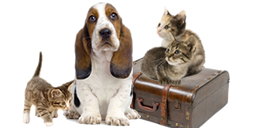
Travel: Taking Toto On The Road
By Malcolm Beith
NEWSWEEK INTERNATIONAL
How to travel with your pet
Feb. 24 issue — On paper, Ruggles seems like your ordinary world traveler. He’s been to France, Germany, England, Costa Rica and Canada. He’s hopped over from his home in Ft. Lauderdale, Florida, to Mexico at least half a dozen times.
HE’S EVEN GOT frequent-flier miles on America West. But Ruggles isn’t a teen-ager taking a year off before college or a retiree with too much time on his hands. He’s a 14-year-old Shih Tzu.
Ruggles’s owner, Jerry Hatfield, is just one of many pet lovers worldwide who have started taking their companions along on holiday. In recent years pet travel has become increasingly commonplace, and September 11 seems to have added fuel to the trend. Says Hatfield, who runs PetTravel.com , “People are less willing to go off and leave a part of their family at home, either for security reasons or psychological reasons.” As a result, the tourism industry is growing more accommodating to the four-legged set and more aware that traveling pet own-ers are “really good business.” Here are a few tips for taking Rover (or Fluffy) along on your trips:
Road or rail? “Always plan ahead,” says Dawn Habgood, owner of two golden retrievers and coeditor of petsonthego.com. Seems logical enough. First, decide where you want to go and how you want to get there. Trains don’t usually take pets, and the same goes for cruise ships. If you have a cat, think twice before flying. “Cats are not very good travelers, unless you’re going by car,” says Hatfield. But remember: some animals do suffer from car sickness, so it’s best to “test drive” your pet first. Bring some water—pets get thirsty on even the shortest of rides. And dogs need to stretch every two to three hours, so make frequent pit stops.
Flying high: If you are intent on flying the pet-friendly skies, be sure to call the airline ahead of time—policies and prices change frequently and vary from one carrier to the next. Clearly specify how large your pet is. Most airlines allow small pets—under 15 pounds—in the passenger cabin at an average cost of $50, as long as they’re in an approved soft animal carrier like a Sherpa Bag and you can stow them under the seat in front of you on takeoff and landing.
If your pet is headed for the cargo area (cost: up to $200), be —sure to plan the timing of your trip accordingly. Most airlines have a no-pet policy during the hottest and coldest months of the year. Throw a toy in the carrier, freeze some water in a dish (as it thaws, your pet can lap it up without severe spillage) and tape some food outside the carrier in case of a delay. That way a flight attendant can feed Fido while he waits for takeoff.
Medical musts: Most countries require recent vaccinations and certificates to prove the animal’s state of health. Some, like Britain, require pet passports—a microchip about the size of a grain of rice embedded in your pet’s skin that contains information on ownership and recent vaccinations. The pet passport can usually be obtained through your vet for roughly $200, though prices vary. Pet quarantines are less common now than before, but some nations—like Ireland (unless you’re arriving from Britain) and South Korea—still require them.
A handful of establishments—particularly those in the United States, where pet travel is a relatively new phenomenon—now offer VIP treatment. Loews Hotels ( loewshotels.com ), with branches across North America, offers extras like dog and cat beds and a pet room-service menu that includes grilled lamb, chicken with rice and even a vegetarian option. Although this is not the industry standard, pet travelers agree that many hoteliers go out of their way to treat them well. One hotel manager once admitted to Hatfield that he’d “so much rather have a pet in the hotel than a small child.” These days, many pet “moms” and “dads” can’t tell the difference.
© 2003 Newsweek, Inc.


